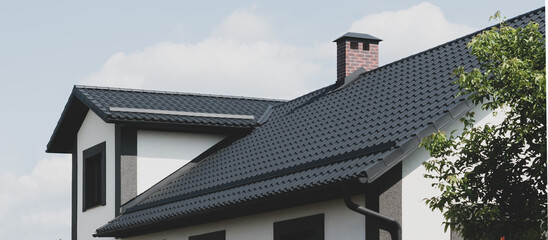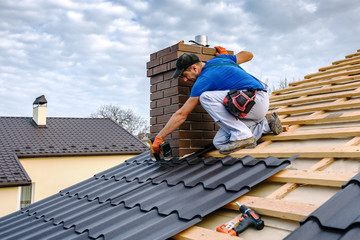Residential roofing is the material and installation that protects homes from the elements. Lakewood Roofing also enhances curbside appeal and reflects the house’s architectural style.
The roof frame consists of rafters or trusses (prefabricated webs). The sheathing, which is typically oriented strand board or plywood, is then placed on top.
Repair
 Residential roofing involves constructing, installing, repairing, and maintaining roofs on homes or other structures meant for human habitation. It encompasses many roofing materials and designs, including asphalt shingles, metal, tile, wood, and others. Unlike commercial structures, which often feature flat surfaces, residential roofs tend to be steeper and designed to look aesthetically pleasing.
Residential roofing involves constructing, installing, repairing, and maintaining roofs on homes or other structures meant for human habitation. It encompasses many roofing materials and designs, including asphalt shingles, metal, tile, wood, and others. Unlike commercial structures, which often feature flat surfaces, residential roofs tend to be steeper and designed to look aesthetically pleasing.
The roof repair process typically begins with an inspection of the damaged area to determine the extent of the damage and underlying problems. The contractor will remove the affected shingles, inspect and replace damaged flashing or underlayment, and caulk any potential openings. He or she may also make repairs to sagging roof decks.
Before the work begins, your contractor should discuss safety protocols with you and explain how the project will progress. Be sure to ask about their credentials, experience, warranty, and references. Also, be clear about your budget and expectations up front to help the contractor provide you with the best options within your price range. Depending on the scope of the work, the entire process can last from a single day to a week or more.
Replacement
Residential roofing involves protecting structures designed for human habitation, like homes and apartments. A roof’s job is to protect the structure below from harsh weather elements, but it can also add to a building’s aesthetics and functionality. Residential roofs are usually easier to create and maintain than commercial ones, but they require a quality professional and the right materials to keep them in good condition.
A residential roof is comprised of a decking system, shingles, and underlayment. The decking system acts as a base for the other layers of the roof, providing a surface that shingles and underlayment can be attached to. It also helps to regulate indoor temperatures and prevent leaks. The shingles act as the outer layer, protecting the underlying layers from moisture and debris. There are many different types of shingles, but asphalt shingles are the most popular. They come in a variety of colors and styles to suit any home’s design. Other shingle options include metal, tile, and cedar shakes.
When you’re ready to replace your residential roof, the first step is to find a reputable roofing company with experience in residential roofing. A good roofing contractor will walk you through the process and help you choose the best roofing materials for your home. They will also provide a detailed timeline and warranty information. Before beginning any work, they should secure the necessary permits and approvals.
Before a new roof is installed, it’s important to prepare the site. This includes clearing the area of toys and patio furniture, removing anything that could be damaged by falling shingles, and covering any items stored in the attic or crawlspace. Roofing professionals will need to access your roof from multiple sides, so it’s essential to leave them a clear path without obstructions.
Before starting a project, you should always ask a roofing professional to inspect your roof for damage and wear. This will allow them to identify issues early and offer advice on the proper course of action. They can also recommend additional services, such as gutter cleaning or roof repairs. Keeping up with regular maintenance and inspections will ensure that your roof stays in great condition for years to come.
Installation
Residential roofing covers the construction, repair, and maintenance of roofs on homes. It uses various roofing materials and techniques to protect the building and enhance its curb appeal. It also helps regulate indoor temperature and ensures safety and comfort for residents. Residential roofs are usually made of asphalt shingles, metal, tile, or wood. Each type has its own benefits and drawbacks, so homeowners should carefully consider the options before making a decision.
A successful roof installation depends on the quality of the materials and the craftsmanship. The first step is an inspection and consultation with a professional roofing contractor. The contractor will examine the current state of the roof and discuss the homeowner’s preferences and budget. They will also provide an estimate and explain the process of repairing or installing a new roof.
During this phase, the roofing contractor will identify any potential issues and recommend solutions. For example, they may suggest replacing damaged shingles or repairing the gutter system. They will also determine the best roofing material for the home, ensuring that it is compatible with the structure’s design and meets local building codes.
The next step is to install the underlayment, which acts as a protective barrier against water infiltration. It is available in several forms, including synthetic underlayment and felt paper, and each provides a different level of protection. The roofing contractor will then attach the shingle tabs to the roof decking, using either nails or adhesives. The shingles are then covered with caulking to prevent moisture from seeping into the home.
Finally, the roofing contractor will install flashing around chimneys, vents, valleys, and other vulnerable areas. This prevents water from leaking into the house and helps to ensure that it stays weatherproof. The final step is a thorough cleaning and a final inspection to ensure that the job is done correctly.
Whether you are replacing your roof or building a new house, a sturdy and well-maintained roofing system is essential for preventing damage and maintaining your property’s value. Understanding the residential roofing process will help you make informed decisions about your roof’s maintenance and repairs.
Maintenance
Residential roofing consists of the roofs on houses and small apartment buildings. It is different from commercial roofing, which encompasses large structures like warehouses and shopping malls. The main difference is that commercial roofs are typically flat while residential roofs have a sloped design. This affects the materials used, installation methods, and maintenance required.
During the maintenance process, professional roofing contractors address any issues that may have arisen from weather or natural wear and tear. They also inspect for potential problems, such as loose shingles or leaks. In some cases, homeowners may need to replace a single shingle or repair a minor leak in a ceiling or attic.
A residential roof should be inspected routinely to prevent problems from occurring and to ensure the safety of the home’s occupants. Inspections are generally performed at least once a year, but may be done more often depending on the conditions of the roof and the climate in the area. For example, a roof in an area that experiences snowy winters might require pre-winter inspections to make sure the roof can support the weight of snow and ice.
In addition to inspecting the integrity of the shingles, residential roofers look at the condition of all components of the roofing system. They check the flashing (metal installed where shingles butt up against walls, chimneys, valleys, skylights, and other penetrations) to ensure it is intact, watertight, and not leaking. They also examine the vents to verify they are free from blockages, duct tape, and paint. They also check soffit screens to confirm that they are not clogged with stored items or insect hives.
Depending on the condition of the roof, other maintenance items might include cleaning gutters to prevent clogging, clearing debris from drains, and checking attic ventilation and insulation to ensure that the home is comfortable and energy-efficient. Keeping up with regular maintenance on residential roofs can help protect the value of the home and extend its lifespan. For the best results, a residential roofing company should be contacted regularly to perform a thorough inspection and make any necessary repairs.

